Removable upper jaw prosthesis

Removable dentures are dental structures whose main purpose is to restore the function of chewing and aesthetics.
They got the name “removable” due to the fact that the patient can take them off and put them on.
To date, removable dentures are still as popular as before. Modern dentistry has the opportunity to offer patients various options for removable prosthetics of the upper jaw.
The more teeth the patient has left, the more diverse the choice of removable dental structures.
Features of prosthetics
Removable upper jaw prostheses have a number of features:
- The choice of design and manufacture are not difficult, since the upper jaw has sufficient area to support the base.
- The design is perfectly fixed due to the presence of an additional fulcrum.
- Reliable fastening of complete prostheses ensures the presence of a large valve zone.
- When using partial dentures, the abutment teeth are subject to less pressure and a more even distribution of the masticatory load.
- Even in the case of complete adentia, the design on the upper teeth is able to fully perform its functions.
- Do not cause discomfort when using.
- There is no displacement of the prosthesis when eating.
- It has an aesthetic appearance.
Indications
Upper jaw prosthetics are indicated for:
- Partial tooth loss.
- End defects of the dentition.
- Strengthening teeth during periodontal disease.
- Complete adentia.
- If it is impossible to carry out fixed prosthetics.
Kinds

There are removable dentures of the following types:
- Complete removable structures (lamellar) are used in the complete absence of teeth on the jaw.
- Partially removable denture (clasp, plate, removable segments or sectors). Such designs are equipped with locking elements: hooks, micro locks.
- Conditionally removable dental structures.
Depending on the purpose, the designs can be permanent (used by the patient constantly) and temporary (used for the period until a permanent denture is made).
Complete denture
A removable denture on the upper jaw rests on the gum and on the palate, and a complete denture on the lower jaw is fixed only on the gum.
In the absence of teeth, the structures are held in the mouth due to the effect of suction and adhesion to the gums.
In this regard, the basis area of such prostheses is large.
When fixing, the removable upper prosthesis should also capture the hard palate, otherwise, the structure will not be fixed.
- The laminar denture for the upper jaw is made of acrylic plastic or nylon.Acrylic constructions correctly distribute the chewing load on the gums and allow its owner to fully chew food.
- Due to its great flexibility, a removable nylon construction on the upper jaw is rarely used.
Partially removable prosthetics of upper teeth
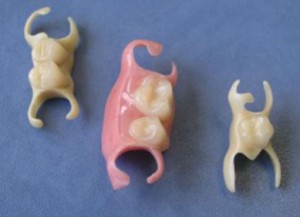
Laminar denture
- Plate constructions can be made of plastic or nylon.
- Acrylic and nylon constructions are equipped with clasps that cover abutment teeth. Due to them, the prosthesis is fixed in the mouth.
- If the patient does not have one or two teeth in a row on the jaw, then a butterfly prosthesis can be used.
Nylon prosthesis
They are made of nylon.
- Nylon designs have aesthetic advantages over acrylic and clasp dentures.
- However, they have several disadvantages: lack of addiction to the design, the impossibility of a full meal.
Clasp prosthesis
Clasp dentures are considered more physiological, distributing evenly the load when chewing between the teeth and gum.
- Designs consist of a metal arc and a base with artificial teeth. Clasp constructions are lighter, more durable and take up very little space in the oral cavity.
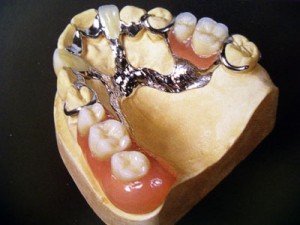
Photo: Clasp prosthesis on the upper jaw - An arched plate on the upper prosthesis passes through the dome of the sky and, compared with the plate design, takes up very little space.
- Arch clasp prostheses are made from medical alloys, but in some cases, and from precious metals. For the manufacture of arcs of temporary clasps, a special polymer can be used.
- Teeth for clasp constructions are made of ceramic or composite. Clasp dentures can be used to splint teeth when loosening.
- Clasp constructions are fixed in the mouth with the help of clasps, which are branches of a metal frame. The disadvantage of such a fixation is that if the clasps fall into the smile line, then such designs look completely unaesthetic.
- Fixing with attachments (micro locks) is quite aesthetic, since micro locks are completely invisible during a conversation. Crowns are put on the supporting teeth, and attachment elements are mounted on them and a removable design. When fixing the prosthesis, parts of the micro-locks are connected and snap into place.
Removable segments or sectors
These are designs that are used to restore upper or lower teeth on one half of the jaw.
- They are used as temporary prostheses to restore the functionality of the dentition for the period of manufacture of the permanent structure.
- Used rarely enough due to the mismatch of the requirements of modern dentistry.
Conditionally removable dentures on implants
They are made in the complete absence of teeth on the upper or lower jaw.
Dentures on implants are used to better fix the structure in the oral cavity.
This type of prosthesis is called "cover" dental designs.
Options for prosthetics
Push Button Lock
- Two or three implants are implanted in the jawbone, into which spherical locks are screwed.
- Recesses are made on the inner surface of the removable structure and silicone matrices are inserted into them.
When fixing the prosthesis to the jaw, the lock heads fall into the silicone matrix and the structure is securely fixed.
Beam Mount Type
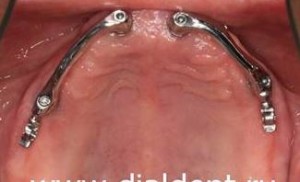
- Two or three implants are implanted in the bone tissue of the jaw, and a metal beam is laid between them.
- In its projection, a recess is made on the inner side of the structure, which corresponds to the size of the beam.
- Silicone matrices are placed in the recess, which, when donning the prosthesis, firmly wrap around the beam.
Thus, the structure is firmly fixed in the mouth.
On intracanal implants
- The crowns of the preserved teeth are cut under the root, after which the root canals are filled.
- Then implants are implanted with an element protruding above the root in the form of a metal head.
- In the projection of metal heads on the inner surface of the structure, recesses are made into which silicone matrices are inserted.
As a result, the prosthesis is securely fixed, and due to the living roots of the teeth there are no atrophic changes in the bone tissue, which leads to an increase in the service life of the structure.
Video: “How reliable are removable dentures?”
Cost
| Type of construction | Prices in rubles |
| Removable acrylic denture on the entire jaw | From 8 to 20,000 |
| Plastic denture for 2 teeth | From 3000 |
| Partial clasp prosthesis with micro-locks | From 40,000 |
| 1-3 tooth nylon prosthesis | From 15000 |
Reviews
- I installed a removable nylon prosthesis on the upper two chewing teeth. The design is perfectly fixed, not shifted. I got used to the prosthesis for several months. Gradually got used to the prosthesis and now, when I take off, I immediately feel that something is missing.
- I have been using a partial acrylic denture for eight months. The design is tough, but I gradually got used to it. Some time ago, the tooth's sensitivity to temperature changes, touch, sour or sweet food increased. Upon examination, it turned out that the clammer damaged tooth enamel. The dentist performed tooth fluoridation.
- She placed a partial nylon prosthesis on the upper jaw. Long got used to the design. Several times I had to carry out the correction until the prosthesis sat down, as it should. Due to frequent adjustments from the design, rags remained. The prosthesis cannot be polished. I would like to replace the prosthesis, but I do not have the opportunity. In short, very dissatisfied with prosthetics, sheer frustration.
- I installed a removable plastic prosthesis. The price of the design was quite fine with me, but the quality of the design is poor. The design rubbed the gums, caused pain. During the meal I felt terrible discomfort. For a year I’m not used to a prosthesis.
Photo: before and after
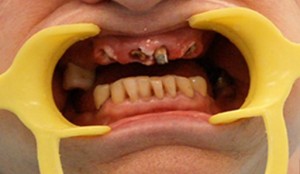 |
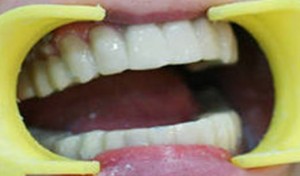 |
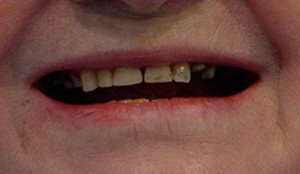 |
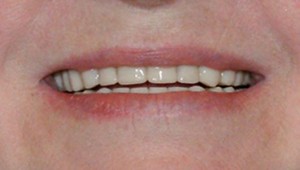 |
 |
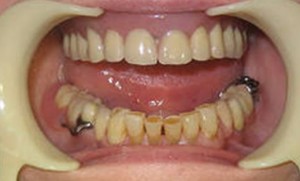 |